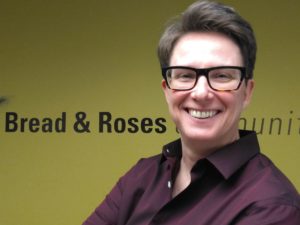Does COVID-19 recovery depend on the kindness of strangers?
 March 15, 2021
Category: Featured, Funding, Long
March 15, 2021
Category: Featured, Funding, Long
It was a year ago when the coronavirus first made its way into Pennsylvania. The Center for Disaster Philanthropy has called the chaos that followed “a complex humanitarian emergency.”
It included massive unemployment, evictions, death and long-term ill health, small business closures, unsafe work environments, food insecurity, utility debt, social protests, declining mental health. COVID-19 rained problems upon the United States on a scale that left the nonprofit community struggling to support both its clients and itself.
The once-in a-century pandemic revealed this: America’s basic needs safety net infrastructure is a patchwork of efforts stitched together by dedicated frontline nonprofit organizations.
It also showed that the funds to provide these critical basic needs essentially comes from the kindness of strangers.
In the wake of the pandemic, donations from individuals, donor-advised funds and foundations flowed in. According to the report, Philanthropy and COVID-19: Measuring one year of giving from Candid and the Center for Disaster Philanthropy, more than $10.7 billion in U.S. grantmaking was raised in 2020 for COVID-19 challenges.
Locally, the Center for High Impact Philanthropy (CHIP) at the University of Pennsylvania tracked and analyzed $40 million in COVID relief funding grants that had been distributed through 13 shared funds in the Delaware Valley. Over 8,500 contributors gave $18 million to the PHL COVID-19 Fund, the largest local COVID-19 relief grantee, to support about 500 regional front-line nonprofits.
“People know that grassroots groups have stepped up to address this crisis, so they are eager to support that work. For example, 360 donors made gifts to our most recent Giving Project, which focused on environmental justice and was able to make $180,000 in grants to grassroots community organizing groups,” said Casey Cook, executive director of Bread & Roses Community Fund.
Despite the outpouring of donations, in Pennsylvania, 80 percent of nonprofits reported revenue loss and by the end of last year 930,000 nonprofit jobs had been lost, many in the arts and entertainment sector. Jacob Harold, Candid’s executive vice president, told The Associated Press, “If you are a donor who cares about an organization that is rooted in place and relies on revenue from in-person services, now is the time, probably, to give more.”
As we move from relief to recovery, what is the current state of pandemic giving:
Individual Giving
About 70% of all giving comes from individual donors. In 2019, that totaled almost $310 billion, with half of that money going to religious and educational organizations.
“In December, we had record-setting donor support for our programs — particularly our work preventing and addressing homelessness, fighting hunger, and ensuring family stability. We have been able to increase service as a result,” said Marissa Christie, CEO & president of United Way of Bucks County.
But the research also shows that for the average nonprofit, 88% of the organizations’ fundraising come from just 12% of the donors.
In addition, large gifts from mega-donors have masked that there’s been a two decade decline in the number of small and mid-size individual donors making larger donors increasingly important and raising concerns that the lack of a diverse, small donor base will ultimately hurt the independence of the nonprofit sector.
And then there is donor fatigue.
“I understand concerns about donor fatigue,” Christie said. “We are still working through a long-term global crisis.But I think what donor fatigue really means that we have repeatedly approached the same donor with the same problem without proving that their previous support made a difference. I believe our donors stay with us because we can show the kind of progress we are making with their support. We need donors to know what is different and better because of their generosity.”
Community Foundations and Donor-Advised Funds
More than half of all grants came from community foundations putting them on the philanthropic front lines. But most of these grants were small with a median award size of $10,000. Still, community foundations played a vital role—creating COVID-19 funds, partnering, and coordinating with local governments and organizations, and providing support to local nonprofits.
The Community Foundation Public Awareness Initiative, an association of community foundations, reported that almost $7 billion was granted by the donor-advised funds at 84 community foundations —a $2 billion increase over 2019. According to National Philanthropic Trust’s 14th annual Donor-Advised Fund Report, donor-advised funds had a 22.4% payout rate in 2019. Fidelity Charitable, for example, reported that 93% of its donor-advised funds made at least one grant in 2020 with an average grant size of $4,614 up from $4,358 in 2019.
But criticism abounds that donor advised funds should commit to reserving less and distributing more to nonprofit organizations especially in light of rapid growth in assets.
The Philadelphia Foundation, which was one of the first community foundations in the world when it opened a century ago, awarded over $90 million dollars in 2020 which was three times more than usual. In 2018 — the latest annual report available — it had $543 million in assets, 73% of which was endowed, and distributed $35 million to 1,466 community organizations. The Chester County Community Foundation, which has about $64 million in assets, gave $450,000 through its COVID 19 Rapid Response Fund during the first six months of the pandemic. The Foundation for Delaware County, also with $64 million in assets, gave $472,034 to 59 health and human service agencies.
Foundation Giving
Foundations, which must spend a portion of their money each year, donated about $76 billion in 2019. The pandemic hastened a debate in the foundation world where foundations are asked to send more than their legal obligations and to be more flexible by offering multi-year operating dollars, a move that would help stabilize nonprofit organizations.
The Foundation Source reported a 45% increase in the total dollar amount granted and a 2% increase in the total number of grants issued from March -June 2020 compared to the same time in 2019. While giving to nonprofit agencies consumes the bulk of foundation dollars, the report also said that giving to individuals increased 900%.
Foundations are obligated to give a certain amount of money each year. About 800 philanthropic organizations have signed the Council of Foundations MYGOD (multi-year general operating dollars) pledge calling for more grantee-centric practices of less onerous reporting requirements and more resources.
To protect the sector, philanthropy will have to evolve into providing longer term, less restrictive support. The University of PA’s CHIP distills the lessons learned from 2020 into four pieces of advice for donors — give immediately, give flexibly, give consistently, and prepare for the next crisis
In April, the United Way of Greater Philadelphia and Southern New Jersey will launch the Nonprofit Finance Accelerator in partnership with the Nonprofit Finance Fund, which will help nonprofits manage in a new economic landscape.
Project
TRACETrending News











